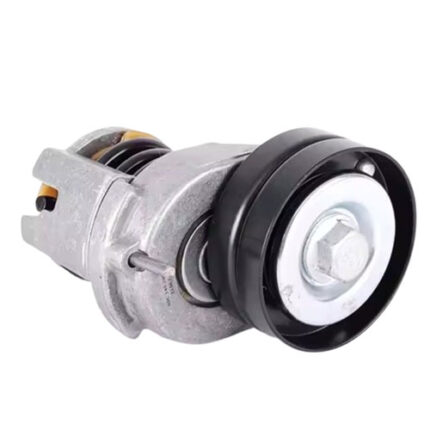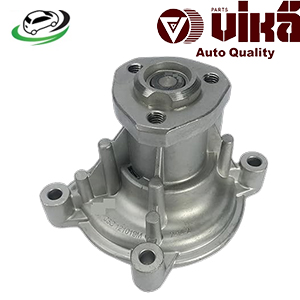-7%
Get Water Pump Engine Cooling AUDI A3 (8P1)/A3 Sportback 8PA / VW EOS 1F7/1F8 /Golf Plus V/Golf V 1K1/Jetta III 1K2/Passat B6 3C2/Touran 1T1/1T2 03C121008C
The water pump is a vital component of your car’s engine cooling system. It plays a crucial role in maintaining the engine’s temperature by circulating coolant (a mixture of water and antifreeze) through the engine and the radiator. Understanding how the water pump works, its importance, signs of failure, and maintenance tips can help you keep your engine running smoothly and prevent overheating.
What is the Water Pump?
The water pump is a mechanical device, usually driven by a belt connected to the engine’s crankshaft. It is typically located at the front of the engine, near the timing belt or serpentine belt. The water pump’s main job is to keep the coolant moving through the engine and the radiator, ensuring that the engine stays at the right temperature.
How Does the Water Pump Work?
Here’s how the water pump functions in the engine cooling system:
- Circulating Coolant: The water pump has an impeller, which is like a small fan or rotor with blades. When the engine runs, the belt turns the water pump’s impeller. As the impeller spins, it creates suction that draws coolant from the radiator into the water pump.
- Pushing Coolant Through the Engine: After the coolant is drawn in, the impeller pushes it through passages in the engine block and cylinder head. As the coolant flows through these passages, it absorbs the heat generated by the engine.
- Returning Coolant to the Radiator: Once the coolant has absorbed the heat, it flows back to the radiator. In the radiator, the coolant releases the heat into the air, lowering its temperature before it is circulated back into the engine by the water pump.
Why is the Water Pump Important?
The water pump is essential for preventing your engine from overheating. Without it, the coolant would not circulate properly, and the engine would quickly become too hot, leading to severe damage. Overheating can cause parts of the engine to warp, crack, or even seize up, resulting in costly repairs or engine failure.
Signs of a Failing Water Pump
Like any mechanical part, the water pump can wear out over time. Recognizing the signs of a failing water pump early can help you avoid serious engine damage. Here are some common symptoms:
- Coolant Leaks: One of the most noticeable signs of a failing water pump is a coolant leak. If you see puddles of coolant (usually a green, orange, or pink fluid) under your car, especially near the front of the engine, it could be a sign that the water pump is leaking.
- Overheating Engine: If your engine temperature gauge is consistently running hot or if you notice steam coming from under the hood, it could indicate that the water pump isn’t circulating coolant properly. This can cause the engine to overheat, which can lead to serious damage.
- Squealing or Whining Noises: A high-pitched squealing or whining noise coming from the front of the engine could be a sign of a worn-out water pump bearing or a loose belt. These noises often increase with engine speed.
- Rust or Corrosion: Over time, the water pump can develop rust or corrosion, which can lead to leaks and reduced efficiency. If you notice rust or a buildup of white, chalky residue around the water pump, it may be time for a replacement.
- Coolant Circulation Problems: If the coolant is not circulating properly, you might notice that your heater isn’t working as well as it should, or that the temperature gauge fluctuates erratically. These could be signs that the water pump is failing.
Maintaining the Water Pump
Proper maintenance of the water pump is key to ensuring your engine stays cool and runs efficiently. Here are some tips to help maintain your water pump:
- Regular Coolant Changes: Coolant not only helps keep the engine cool but also prevents corrosion and lubricates the water pump. Over time, coolant can become contaminated and lose its effectiveness. Regularly changing the coolant according to your vehicle’s maintenance schedule can help prolong the life of the water pump.
- Inspect Belts and Hoses: The water pump relies on the engine’s belts and hoses to function. Regularly inspect these components for signs of wear, cracking, or leaks. Replace any worn-out belts or hoses to ensure the water pump operates smoothly.
- Listen for Unusual Noises: Pay attention to any unusual noises coming from the front of the engine. If you hear a squealing or whining sound, it could be a sign of a problem with the water pump or the belt that drives it. Addressing these noises early can prevent more serious issues.
- Watch for Coolant Leaks: Keep an eye out for any signs of coolant leaks under your car. If you notice a leak, it’s important to have it checked out by a mechanic as soon as possible to prevent the engine from overheating.
- Follow the Manufacturer’s Maintenance Schedule: Your vehicle’s maintenance schedule will often include recommendations for when to inspect or replace the water pump. Following these guidelines can help prevent unexpected failures.
Replacing the Water Pump
If your water pump is failing or has already failed, it’s important to replace it promptly. Replacing a water pump can be a complex job, especially in modern vehicles with tightly packed engine compartments. Here’s a general overview of the replacement process:
- Drain the Coolant: Before removing the water pump, the coolant needs to be drained from the radiator. This prevents coolant from spilling out when the pump is removed.
- Remove the Belt: The belt that drives the water pump needs to be removed. This might be a serpentine belt or a timing belt, depending on your vehicle. In some cases, other components may need to be removed to access the belt and the water pump.
- Remove the Old Water Pump: Once the belt is out of the way, the water pump can be unbolted and removed from the engine. Be prepared for some coolant to spill out, even if the system was drained.
- Install the New Water Pump: The new water pump is installed in the reverse order. It’s important to use a new gasket or seal to ensure a proper seal between the water pump and the engine block.
- Refill the Coolant: After the new water pump is installed and everything is reassembled, the coolant is refilled. It’s important to bleed any air from the cooling system to prevent overheating.
- Test the System: Finally, the engine is started and allowed to reach operating temperature. This ensures that the new water pump is working correctly and that there are no leaks.
Follow us on Facebook for more parts.



